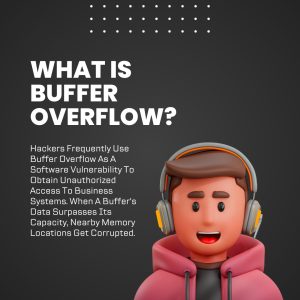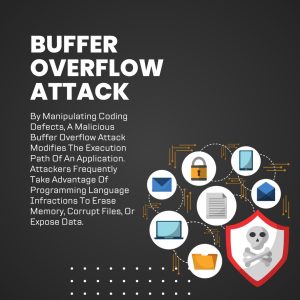What Is The Buffer Overflow And How Its Work ?
In the dynamic world of cybersecurity, understanding vulnerabilities is crucial for protecting digital assets. One such vulnerability that has garnered significant attention is “Buffer Overflow.” This blog aims to demystify the concept, delve into its mechanics, and explore the potential risks associated with this cybersecurity threat.

Buffer Overflow is a type of vulnerability that occurs when a program writes more data to a block of memory, or buffer, than it was allocated to hold. In simpler terms, it’s like pouring more water into a glass than it can contain – the excess spills over and can cause unintended consequences.
Mechanics of Buffer Overflow:
To understand Buffer Overflow, let’s break down its mechanics step by step:
-
Buffers in Programming:
-
-
- In programming languages like C and C++, buffers are used to store data temporarily.
- Buffers have a specific size allocated during the program’s execution.
-
-
Data Input:
-
-
- Programs often receive input from external sources, such as user inputs, file inputs, or network data.
- If the input size exceeds the allocated buffer size, the excess data can overflow into adjacent memory locations.
-
-
Memory Corruption:
-
- Overflowing data can overwrite critical information stored in adjacent memory, leading to memory corruption.
- This corruption can potentially alter program behavior, crash the application, or even open the door for malicious exploits.
Exploiting Buffer Overflow:
-
Code Injection:
-
-
- An attacker may craft input data to inject malicious code into the program’s memory.
- The overflowed data, when executed, can lead to the execution of the injected code.
-
-
Control Flow Hijacking:
-
-
- By carefully manipulating the overflowed data, attackers can overwrite function pointers or return addresses.
- This allows them to redirect the program’s control flow to execute arbitrary code, potentially compromising the system.
-
-
Malware Propagation:
-
- Buffer Overflow vulnerabilities can be exploited to inject and execute malware on a system.
- This makes it a potent weapon for attackers seeking unauthorized access or control.

Preventing Buffer Overflow:
-
Bounds Checking:
-
-
- Implement strict bounds checking to ensure that data input does not exceed the allocated buffer size.
-
-
Use of Safe Programming Languages:
-
-
- Choose programming languages with built-in safety features, like Java or Python, which automatically handle memory management.
-
-
Address Space Randomization:
-
- Randomize the memory addresses of key system components to make it challenging for attackers to predict and exploit vulnerabilities.
Mitigating Buffer Overflow: Best Practices
While understanding the mechanics of Buffer Overflow is essential, implementing effective mitigation strategies is equally crucial to fortify your systems against potential threats. Here are some best practices to help prevent and mitigate Buffer Overflow vulnerabilities:
1. Code Audits and Reviews:
- Regularly conduct thorough code audits and reviews to identify and address potential vulnerabilities.
- Emphasize secure coding practices and ensure developers are well-versed in identifying and preventing Buffer Overflow issues.
2. Input Validation:
- Implement robust input validation mechanisms to ensure that data entering the system adheres to predefined limits.
- Reject or sanitize input that exceeds specified boundaries to prevent overflow scenarios.
3. Stack Canaries:
- Introduce stack canaries, which are random values placed between local variables and control data.
- If a Buffer Overflow attempt occurs, the canary value will be altered, triggering an alert or terminating the program.
4. ASLR (Address Space Layout Randomization):
- Enable ASLR to randomize the memory addresses of key system components, making it challenging for attackers to predict the location of vulnerable code or data.
5. Use Safe String Functions:
- Replace standard string functions like strcpy and strcat with safer alternatives like strncpy and strncat that allow developers to specify the maximum number of characters to copy.
6. Data Execution Prevention (DEP):
- Enable DEP to prevent the execution of code in specific regions of memory, making it difficult for attackers to inject and execute malicious code.
7. Regular Software Updates:
- Keep software and operating systems up-to-date with the latest security patches.
- Vendors often release updates to address known vulnerabilities, including those related to Buffer Overflow.
8. Security Training and Awareness:
- Provide regular security training to developers, system administrators, and other personnel involved in the software development lifecycle.
- Promote awareness of common attack vectors and the importance of adhering to secure coding practices.
9. Intrusion Detection and Monitoring:
- Implement intrusion detection systems to monitor for unusual behavior or patterns that may indicate a Buffer Overflow attack.
- Promptly investigate and respond to any detected anomalies.
10. Use Memory-safe Programming Languages:
- Consider using programming languages with memory safety features, such as Rust or Swift, which inherently prevent certain types of memory-related vulnerabilities.
Conclusion
By adopting a multi-faceted approach that combines secure coding practices, technological solutions, and ongoing awareness, organizations can significantly reduce the risk of Buffer Overflow vulnerabilities. As cyber threats continue to evolve, maintaining a proactive stance and implementing these best practices are essential for safeguarding critical systems and data from potential exploits.

